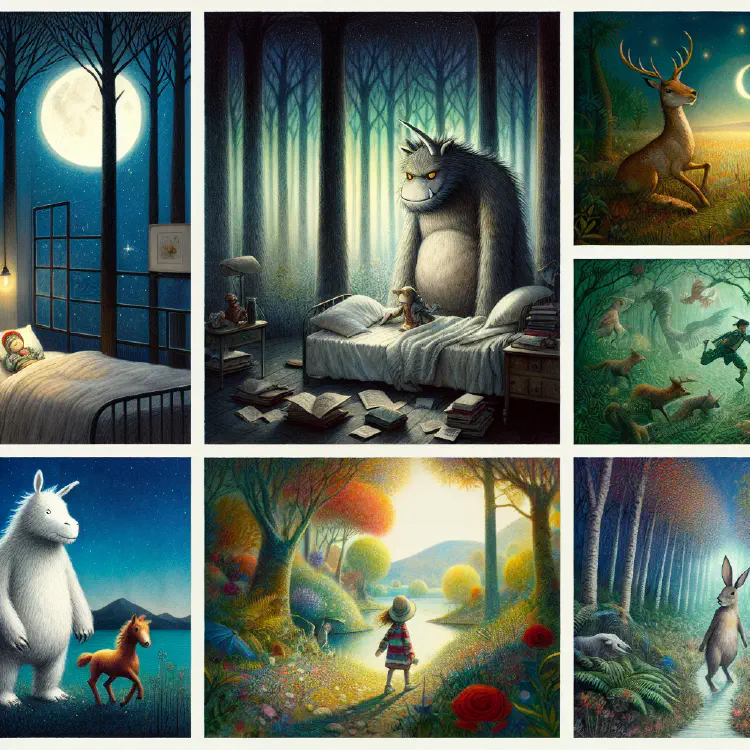The Best Illustrations in Bedtime Story Books
Illustrations in bedtime stories engage children, aid comprehension, spark imagination, create emotional connections, and enhance memory retention. Examples from popular books demonstrate their importance.
- 3 min read

Bedtime stories have been a cherished tradition for generations, captivating young minds and lulling them into peaceful slumber. While the narratives themselves are undoubtedly important, the illustrations that accompany these tales play a crucial role in bringing the stories to life and creating lasting memories for children. In this blog post, we’ll explore some of the most enchanting and memorable illustrations found in popular bedtime story books, discussing why they’re so effective and how they contribute to the overall reading experience.
The Importance of Illustrations in Bedtime Stories
Before we dive into specific examples, let’s take a moment to consider why illustrations are so vital in bedtime stories for kids. Visual elements in books serve several purposes:
Engagement: Colorful and detailed illustrations capture children’s attention, making them more likely to stay focused on the story.
Comprehension: Pictures help young readers better understand the narrative, especially for complex concepts or unfamiliar words.
Imagination: Well-crafted illustrations spark creativity and encourage children to imagine beyond the confines of the text.
Emotional connection: Visuals can evoke strong emotions, helping children connect more deeply with the characters and storylines.
Memory retention: Children often remember stories better when associated with vivid imagery.
Now, let’s explore some of the most beloved illustrations in popular bedtime stories for preschoolers and toddlers.
- “Goodnight Moon” by Margaret Wise Brown, illustrated by Clement Hurd
“Goodnight Moon” is a classic bedtime short story that has captivated generations of young readers. Clement Hurd’s illustrations are simple yet effective, using a limited color palette to create a cozy, dreamlike atmosphere. The gradual darkening of the room as the story progresses is a subtle touch that mimics the natural process of falling asleep.
What makes these illustrations special:
- The use of bold, primary colors that appeal to young children
- The repetition of familiar objects throughout the book, encouraging recognition and engagement
- The clever incorporation of a mouse in each spread, providing a fun seek-and-find element
- “Where the Wild Things Are” by Maurice Sendak
Maurice Sendak’s “Where the Wild Things Are” is renowned for its imaginative storyline and equally fantastical illustrations. The book’s visual style evolves as the protagonist, Max, journeys into his imaginary world, with the illustrations gradually expanding to take up more space on the page.
Standout features of Sendak’s illustrations:
- The intricate details of the Wild Things, each with its own distinct personality
- The use of cross-hatching and other techniques to create texture and depth
- The seamless blend of reality and fantasy in the visual narrative
- “The Gruffalo” by Julia Donaldson, illustrated by Axel Scheffler
“The Gruffalo” is a modern classic that has become a favorite bedtime story for toddlers. Axel Scheffler’s illustrations bring Julia Donaldson’s rhyming tale to life with vibrant colors and expressive characters.
What makes Scheffler’s illustrations memorable:
- The whimsical design of the Gruffalo, both fearsome and endearing
- The lush forest backgrounds that create a rich, immersive environment
- The consistent style that ties together the various animal characters
- “The Tale of Peter Rabbit” by Beatrix Potter
Beatrix Potter’s “The Tale of Peter Rabbit” features delicate watercolor illustrations that have stood the test of time. Her attention to detail and naturalistic style make the animal characters feel both realistic and relatable.
Highlights of Potter’s illustrations:
- The soft, muted color palette that creates a gentle, soothing atmosphere
- The accurate depictions of flora and fauna, reflecting Potter’s love of nature
- The expressive faces of the animal characters, conveying a range of emotions
- “The Very Hungry Caterpillar” by Eric Carle
Eric Carle’s distinctive collage-style illustrations in “The Very Hungry Caterpillar” have made it one of the most recognizable bedtime stories for preschoolers. The bold colors and unique textures created by Carle’s technique make each page a visual feast.
What sets Carle’s illustrations apart:
- The use of hand-painted papers to create textured collages
- The vibrant color combinations that appeal to young children
- The
